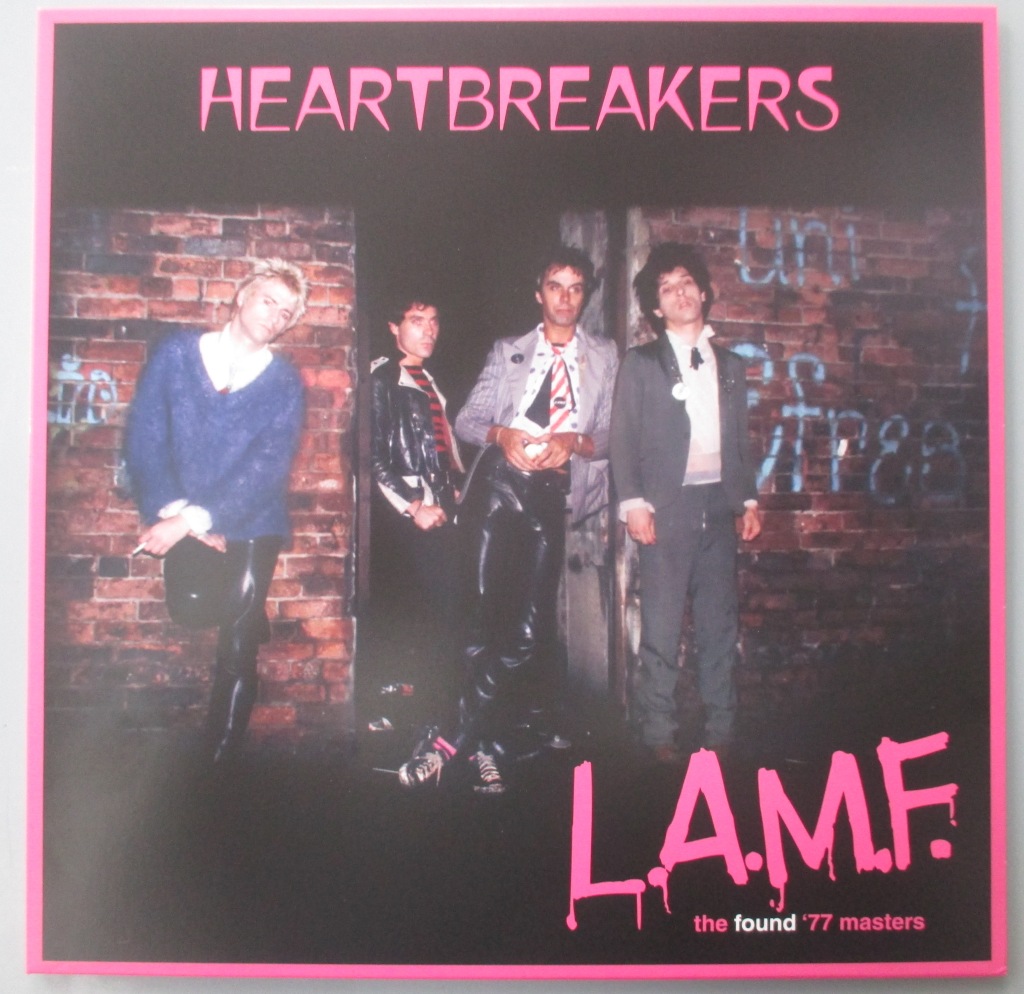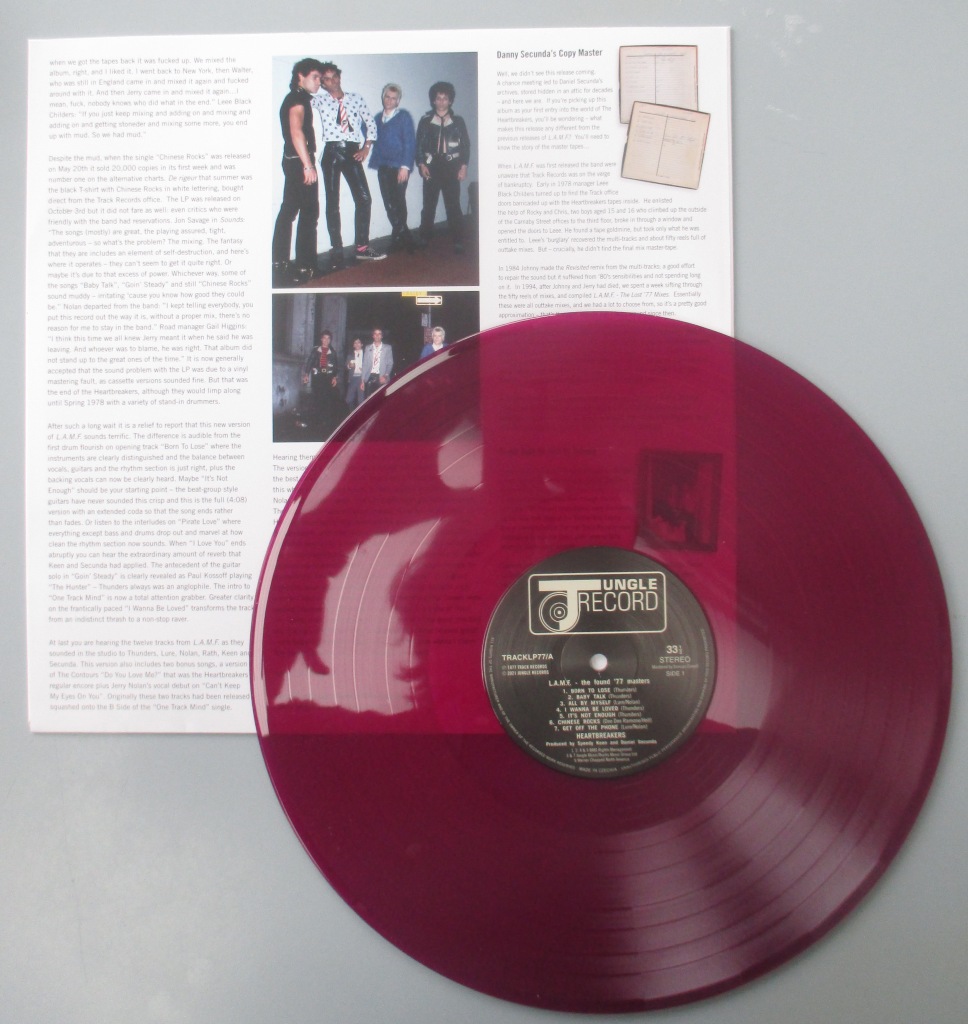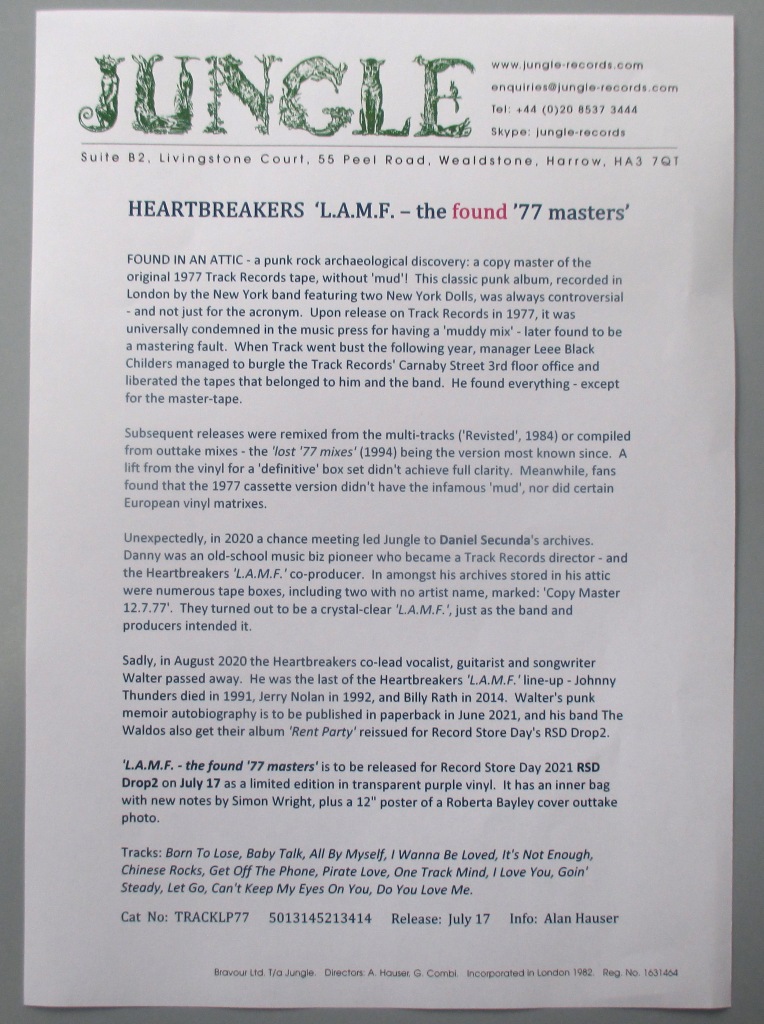LAMF – The Found ’77 Masters

Jungle TRACKLP77
My copies arrived this morning and it looks great. Heavy card sleeve, coloured vinyl, printed inner with my sleeve notes intact and a colour poster from a Roberta Bayley out-take (not shown here: you’ll have to buy the LP!).
Release date is RSD#2, July 17th.
L.A.M.F – The Found ‘77 Masters
Simon Wright, with thanks to Nina Antonia
This record rights a historical wrong as well as answering a key “what if?”. What if the Heartbreakers 1977 debut LP L.A.M.F. (Like A Mother Fucker) had sounded as good as their incendiary live performances? Finally we can hear L.A.M.F. as it was meant to sound and the results are revelatory. So how did this happen and why does it matter?
The Heartbreakers arrived in the U.K. in December 1976 perfectly placed to take advantage of the renewed interest in raucous rock’n’roll stirred up by punk going mainstream. The reputation of main man Johnny Thunders and drummer Jerry Nolan preceded them from their time in the New York Dolls: bassist Billy Rath and guitarist / vocalist Walter Lure made up the quartet. Note it is the Heartbreakers – not Johnny Thunders & The Heartbreakers. This was a four-way unit, not a star and backing band: everyone had their part to play. As Blondie’s drummer Clem Burke said to author Curt Weiss “You could call them the punk rock Beatles. Each person really stood out.”
The Heartbreakers had been invited to the UK by ex-New York Dolls manager Malcolm McLaren to support his new proteges the Sex Pistols on their Anarchy In The UK tour. As Heartbreakers manager Leee Black Childers remembers “We would have toured with anybody, even Barry Manilow”. Sadly most of the tour was cancelled, leaving the Heartbreakers stranded penniless in London. Childers “The first gig we did in London was at Dingwalls and it was magnificent. You couldn’t have got another person in there with a crowbar! It was so packed. I thought…Oh boy…we’re gonna be the next Beatles, we’re gonna be soooo rich. Of course, the last Beatles weren’t wildly self-destructive junkies.” The next gig was at Andrew Czezkowski’s Roxy Club in Covent Garden, which is where Only One’s guitarist John Perry saw them play the gig of their lives. Like The Only Ones, the Heartbreakers were keen on late-night rock’n’roll youth club The Speakeasy, not least because it was where the A&R community hung out. Track Records had been keen to sign the New York Dolls back in 1972 and it was second time lucky when they signed the Heartbreakers, assigning them as producers Danny Secunda and Speedy Keen.
Except the band actually signed to The Chris Stamp Band Ltd. Chris Stamp was a director of Track Records as was Kit Lambert: both co-managed The Who. By 1976 the relationship between Stamp, Lambert and The Who was precarious and there was a lot of money at stake. According to Danny Secunda’s unpublished memoirs the legal difficulties facing Track Records were so great that the only way forward was the formation of a subsidiary label, namely The Chris Stamp Band (CSB) Ltd. One key clause in the Heartbreakers deal stated that if CSB Ltd went bankrupt all recordings would revert to Heartbreakers Inc, the company set up by Leee Childers and his business manager Peter Gerber.
The material on L.A.M.F. comes from a variety of sources. “Pirate Love” was in the New York Dolls sets in early 1975. Before coming to the UK the first line up of the Heartbreakers – with Richard Hell on bass – recorded demos at SBS Studios in Yonkers which included “I Wanna Be Loved”, “Chinese Rocks”, “Can’t Keep My Eyes On You” and “Goin’ Steady”. By the time they played Max’s Kansas City on July 23rd 1976 “Born To Lose”, “It’s Not Enough”, “Get Off The Phone” and “I Love You” were in the set. Who actually wrote “Chinese Rocks” continues to be highly contentious: the original L.A.M.F. credits Thunders, Nolan, Hell and Dee Dee Ramone. When the Ramones finally recorded the song for their LP End Of The Century in 1980 it was credited solely to Dee Dee and Richard Hell.
After recording some demos in February 1977, LP sessions commenced in March at Essex Studios and Rampart Studios, the latter belonging to The Who. Recording the basic tracks took around a month: mixing took six months and involved five separate sessions at four different studios – Rampart, Olympic, Trident and Advision. Walter Lure: “The recording of L.A.M.F had gone well but we could never get the sound right on it. We were jealous of the Pistols record ‘cos it had such a great sound and we’d wanted to come up with something as vital, their production was incredible. L.A.M.F. sounded great in the studio but as soon as it went on record it sounded fucked up. We couldn’t get around that: every time we gave them a tape it sounded screwed up.” Johnny Thunders: “None of us was happy with the album mix. It sounded OK when we played the songs in the studio but when we got the tapes back it was fucked up. We mixed the album, right, and I liked it. I went back to New York, then Walter, who was still in England came in and mixed it again and fucked around with it. And then Jerry came in and mixed it again…I mean, fuck, nobody knows who did what in the end.” Leee Black Childers: “If you just keep mixing and adding on and mixing and adding on and getting stoneder and mixing some more, you end up with mud. So we had mud.”
Despite the mud, when the single “Chinese Rocks” was released on May 20th it sold 20,000 copies in its first week and was number one on the alternative charts. De rigeur that summer was the black T-shirt with Chinese Rocks in white lettering, bought direct from the Track Records office. The LP was released on October 3rd but it did not fare as well: even critics who were friendly with the band had reservations. Jon Savage in Sounds: “The songs (mostly) are great, the playing assured, tight, adventurous – so what’s the problem? The mixing. The fantasy that they are includes an element of self-destruction, and here’s where it operates – they can’t seem to get it quite right. Or maybe it’s due to that excess of power. Whichever way, some of the songs “Baby Talk”, “Goin’ Steady” and still “Chinese Rocks” sound muddy – irritating ‘cause you know how good they could be.” Nolan departed from the band: ”I kept telling everybody, you put this record out the way it is, without a proper mix, there’s no reason for me to stay in the band.” Road manager Gail Higgins: “I think this time we all knew Jerry meant it when he said he was leaving. And whoever was to blame, he was right. That album did not stand up to the great ones of the time.” It is now generally accepted that the sound problem with the LP was due to a vinyl mastering fault, as cassette versions sounded fine. But that was the end of the Heartbreakers, although they would limp along until Spring 1978 with a variety of stand-in drummers.

After such a long wait it is a relief to report that this new version of L.A.M.F. sounds terrific. The difference is audible from the first drum flourish on opening track “Born To Lose” where the instruments are clearly distinguished and the balance between vocals, guitars and the rhythm section is just right, plus the backing vocals can now be clearly heard. Maybe “It’s Not Enough” should be your starting point – the beat-group style guitars have never sounded this crisp and this is the full (4:08) version with an extended coda so that the song ends rather than fades. Or listen to the interludes on “Pirate Love” where everything except bass and drums drop out and marvel at how clean the rhythm section now sounds. When “I Love You” ends abruptly you can hear the extraordinary amount of reverb that Keen and Secunda had applied. The antecedent of the guitar solo in “Goin’ Steady” is clearly revealed as Paul Kossoff playing “The Hunter” – Thunders always was an anglophile. The intro to “One Track Mind” is now a total attention grabber. Greater clarity on the frantically paced “I Wanna Be Loved” transforms the track from an indistinct thrash to a non-stop raver.
At last you are hearing the twelve tracks from L.A.M.F. as they sounded in the studio to Thunders, Lure, Nolan, Rath, Keen and Secunda. This version also includes two bonus songs, a version of The Contours “Do You Love Me?” that was the Heartbreakers regular encore plus Jerry Nolan’s vocal debut on “Can’t Keep My Eyes On You”. Originally these two tracks had been released squashed onto the B Side of the “One Track Mind” single. Hearing them blossom into full sonic bloom is wondrous indeed.
The version of L.A.M.F. you are holding now would have been the best LP released in 1977. But if the LP had sounded like this when first released would it have made any difference? Jerry Nolan might have stayed. The LP might have got better reviews. The band might have achieved greater commercial success. However considering the personalities and predilections of the Heartbreakers and their record company it seems unlikely that the band were in for a lengthy career. Thankfully they made this one brilliant studio record which due to the persistence of Alan Hauser at Jungle has been restored to its rightful audio magnificence for you to enjoy. The final word goes to Gail Higgins: “On a good night the band was unsurpassable, it was the epitome of rock and roll. And it was never captured on the recording. Shows were packed because the fans were hoping to get the show of their life. Being their road manager I saw them all – the good, the bad and the ugly. And when they were good, they were beyond great! I only hope a new mix will let those who weren’t there feel the excitement of a Heartbreakers live show. “
“Was That Alright?”

The Found ’77 Master
Alan Hauser
Well, we didn’t see this release coming. A chance meeting, a few discussions, a decision to investigate further and commit – and here we are. If you’re picking up this album as your first entry into the world of The Heartbreakers, you’ll be wondering – what makes this release any different from the previous releases of L.A.M.F.? You’ll need to know the story of the master tapes…
When L.A.M.F. was first released the band were unaware that Track Records was on the verge of bankruptcy. Early in 1978 manager Leee Black Childers turned up to find the Track office doors barricaded up with the Heartbreakers tapes inside. He enlisted the help of Rocky and Chris, two boys from Kentucky aged 15 and 16 who climbed up the outside of the Carnaby Street offices to the third floor, broke in through a window and opened the doors to Leee. Leee remembers “Track Records were not famous for nothing. There were the original multi-track recordings of The Who, Marc Bolan, Jimi Hendrix, Arthur Brown and Thunderclap Newman. We were rich! But I called Peter Gerber and he wisely advised me to take only what belonged to me. So tearfully we left The Who and all the rest behind and took only the Heartbreakers tapes which were legally ours.”
Leee’s ‘burglary’ recovered the multi-tracks and about fifty reels full of mixes – the rights had reverted to the band with the label’s demise. But crucially he didn’t find the final mix master-tape. In 1984 Johnny made the Revisited remix from the multi-tracks: a good effort but it suffered from ‘80’s sensibilities and taking just three nights to complete it. In 1994, after Johnny and Jerry had died, we spent a week sifting through the fifty reels of mixes, and recompiled L.A.M.F. – The Lost ’77 Mixes from those numerous sessions. Essentially these were all outtake mixes and we had to decide which versions worked best. We had a lot to choose from, so it’s a pretty good approximation – that’s the main version that’s been around since then.
Meanwhile, dedicated fans had been comparing different 1977 versions. How come the cassette version didn’t sound muddy? Original Norwegian and French pressings became sought-after, as they didn’t quite suffer the same sound problem. Devotees swapped notes and compiled favourite versions. In 2012, we released a box set with more outtakes and demos and attempted a ‘restored’ Track LP taken from vinyl. However it couldn’t achieve the same clarity as the outtake reels.
Now this copy-master has been found, you can hear L.A.M.F. in the way that Speedy Keen, Danny Secunda and the band originally wanted, with all the clarity they intended. Whichever version you listen to, always remember that it’s the Heartbreakers’ songs and performances that makes L.A.M.F. such an enduring album.

